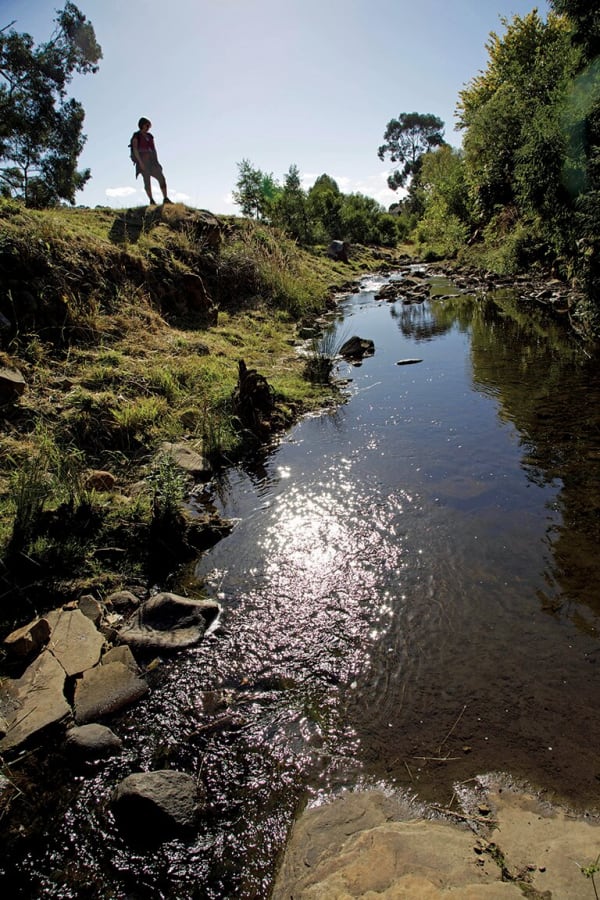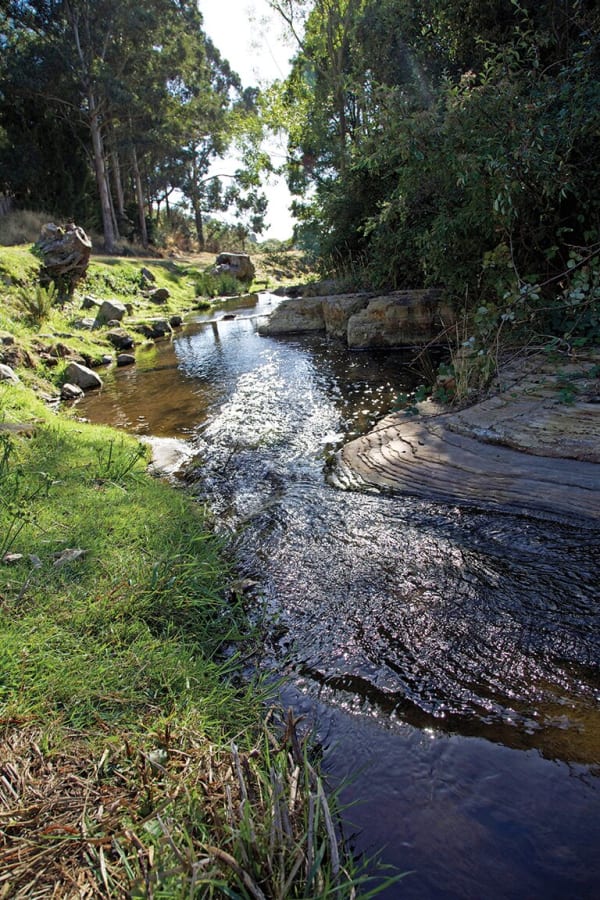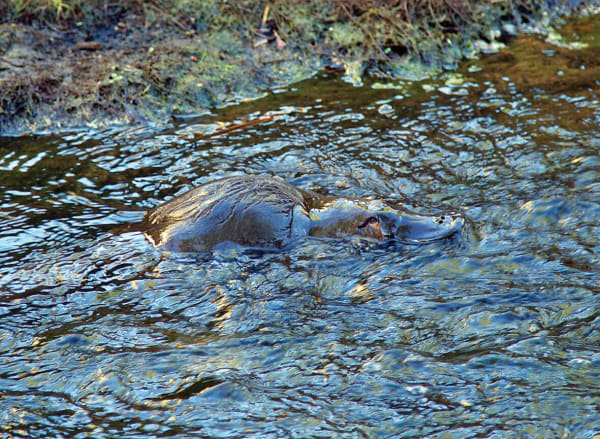“It isn’t as if there was anything very wonderful about my little corner. Of course for people who like cold, wet, ugly bits it is something rather special.” —Eeyore
In describing our rivulet, I risk channelling my inner-Eeyore. The Hobart Rivulet, which nudges our little patch of bush at a few points, is hardly more than a creek. The Scots might call it a burn: a stream across which one can leap. Whatever its name, it’s a narrow, brief, rushing thing which drops from kunanyi and hurries down to join the Derwent a mere seven kilometres later. Steep-sided, scrubby, pocked and youthful, it is a duckling with few prospects of a serene swanhood.

Yet it was the reason the earliest white settlement of southern Tasmania came here, shifting from the drier eastern shore of the Derwent to this wetter western shore where the waters flowing from the cloud-rich mountain are plentiful and reliable. They’d no sooner arrived than they began treating it as a sewer and a drain. Disease inevitably followed, with typhus fever, scarlet fever, and even typhoid breaking out due to the polluted water. By 1843 the town’s medical chief, Dr Robert Officer, declared the rivulet to be “one of the most fertile sources of sickness”, with “dunghills, pigstyes, neglected privies, stagnant water and other accumulations of offensive matter” on clear display along its banks.
Occasionally, our walks take us out of The Patch and down beside that same rivulet. In contrast to Dr Officer’s day, it’s now a delightful The Hobart Rivulet writer and photographer Peter Grant The Patch and pleasant place to be, and we’re far more likely to be surprised by wildlife than struck down with fever. On one of these streamside strolls we have two wild surprises. First up is a tiger snake (Notechis scutatus), the palest I have ever seen. It has an unusual light green hue, and a burnished blush amidships. There are clear cream-coloured stripes hooping up to a back that never darkens beyond business-suit-grey. It’s the stripes that gave these snakes their name, although many – perhaps most – are not noticeably striped.
This one is a decent size, at least a metre and a half long, and it’s moving quickly. I’ve been creeping along the rivulet bank looking for photo angles and must have startled it. The surprise is mutual, yet although the snake is only a couple of metres away, and heading in my direction, my desire to photograph it is stronger than any thought of retreat. The reptile makes the “photo or flight” debate academic. It disappears into a hollow in the stream-side rubble before my camera makes it to eye level.

Given the ample bush, fresh water, and abundance of frogs along the Hobart Rivulet, it shouldn’t surprise us that snakes would favour such a place. As with so much of our wildlife, we see far less than is actually there. As though to prove that point, surprise number two happens just minutes down the track. A man and a woman are standing stream-side, engrossed in watching something. As we join them one quietly says, “Platypus,” pointing to what could well be an animated stone in the water. The remarkable creature is maintaining its position by swimming against the flow. As we watch, it dabbles and ducks beneath the water, intent on finding the invertebrates that are its
staple diet.
How startling it must have been for the first Europeans to come across platypus (Ornithorhynchus anatinus). It was surprising enough that a mammal should have a duck-like bill and webbed feet (anatinus means “duck-like”), as well as a beaver-like tail and a venomous spur. How much more surprising when they discovered that it also laid eggs and yet suckled its young. It broke so many rules of natural history that a sample sent to England was at first dismissed as a hoax. Scientists pored over its ill-preserved body looking for the join marks.
We stare, photograph and ogle for fully 20 minutes more, hardly less engrossed than any early explorer. Here, just a couple of kilometres from the centre of Hobart, is a phenomenon of the natural world, an evolutionary rarity, insouciantly going about its business.

There’s a salutary postscript to this episode. We hear later that “our” Hobart Rivulet platypus has been found dead. There were no signs of external injury, so it was sent to a government laboratory for examination. The report found that “chronic hepatitis and related chronic anaemia” contributed to its death. It was probably a bacterial infection.
Public health has come a long way since the 19th century, yet our rivulet is still undrinkable. And it’s still subject to poisons and diseases that we’re surely capable of eliminating. It’s enough to take anyone to Eeyore’s gloomy place.
Peter Grant lives in the foothills of kunanyi with his wife. He worked with the Tasmania Parks and Wildlife Service for 24 years as manager of interpretation and education. His passion for the natural world led him to write Habitat Garden (ABC Books) and found the Wildcare Tasmania Nature Writing Prize. More of his writing can be seen at naturescribe.com.
Click here to read more from Peter Grant's column, The Patch.








